
Food has been a vital part of human civilization since the dawn of time. It is not only a basic necessity for survival, but also plays an important role in shaping social and cultural practices, as well as economic and political systems. In the earliest human societies, food gathering and hunting were the primary means of subsistence. As human populations grew and became more settled, agriculture and animal husbandry emerged, leading to the development of complex societies with a division of labor and specialization.
Along with the human civilization development and population growth, worries about food production would not keep up with population growth started to arise in the late 1700s. Thomas Robert Malthus (1776 -1834), an English demographer and political economist who is best known for his pessimistic but highly influential view of population growth said in his own words, “The power of population is indefinitely greater than the power in the earth to produce subsistence for man” Malthus’ theory, known as the “Malthusian theory”, was based on the premise that food production increases arithmetically (in a linear manner), while population growth increases geometrically (in an exponential manner). Therefore, he believed that as population grows, the demand for food would eventually surpass the capacity of agriculture to produce it.
However, the theory was criticized for several aspects it didn’t count or consider properly like technology for example. Food production has seen a dramatic increase over the past century, thanks to multiple technological advancements. In many cases, the food production rate has increased more rapidly than the population growth rate. For instance, in the 1930s United States, a quarter of the population worked in the agricultural sector, and the total GDP was less than $100 billion. But today, less than 2% of the population works in the agricultural sector, and the total GDP is more than $14 trillion. Since the 1960s, global growth in agricultural production has outpaced population increase.
But keeping up the level of food production is not the solution to ensure everyone in this world are properly fed. Instead, some problems may arise due to the improper methods used to increase the number. Nowadays, there are three main issues regarding on food that the world face, Food Security, Food Waste, and Sustainable Food Production.
According to the United Nations, food security exists “when all people, at all times, have physical, social, and economic access to sufficient, safe, and nutritious food that meets their dietary needs and food preferences for an active and healthy life.” By the definition itself, we can see that food security is not only covering the production aspect only, but also the economic, nutrition and ensuring that it is distributed equitably and sustainably. And unfortunately, food insecurity is still being a problem today. Food insecurity can be based on inadequate quality or quantity of food. Moderate food insecurity is generally associated with the inability to regularly eat healthy, nutritious diets, while Severe food insecurity is more strongly related to insufficient quantity of food and therefore strongly related to undernourishment or hunger.
Exhibit 1: Share of population with severe food insecurity, 2014 to 2021
Food insecurity is defined by the Food Insecurity Experience Scale (FIES). Severe food insecurity is more strongly related to insufficient quantity of food (energy) and therefore strongly related to undernourishment or hunger.
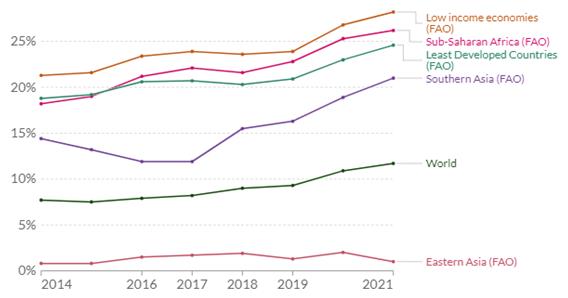
Source: Food and Agriculture Organization of the United Nations
Exhibit 2: Number of severely food insecure people by region
Food insecurity is defined by the Food Insecurity Expericence Scale (FIES). Severe food insecurity is more strongly related to insufficient quantity of food (energy) and therefore strongly related to undernourishment or hunger.
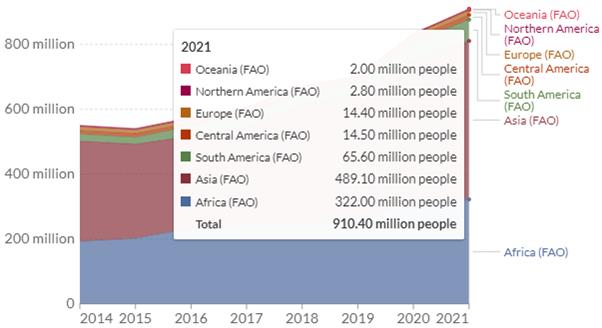
Source: Food and Agriculture Organization of the United Nations
As of 2021, the Food and Agriculture Organization of the United Nations (FAO), 11.7% of world population, or 910.4 million people are defined as severely food insecure. Food insecurity is observed to be more prevalent in areas with poverty problems, which mostly presence in countries of Asia and Africa.
Food security has been a global issue and initiatives to combat it was already involving a lot of global cooperation and not only to parties in the food production or agriculture sector, but also in the financial sector which enabled it. For example, World Bank Group has committed USD 9.6 Million in 2022 to improve food security on promoting ‘nutrition-sensitive agriculture’ and improving food safety via IBRD/IDA. The initiatives include engaging with countries and development partners to address food security challenges. Instruments include rapid country diagnostics and data-based monitoring instruments and partnerships such as the Famine Action Mechanism and the Agriculture Observatory. Participation from various parties are required as food security covered from the production, nutrition, distribution, up until it is received and consumed.
Another issue on its own while still being related to food security that we need to address is generation of food waste. Food waste is a significant contributor to global food insecurity, UNEP
(United Nations Environment Programme) Food Waste Index Report stated that in 2021, food waste from households, retail establishments and the food service industry totals 931 million tonnes each year. It means, on average 74 kg of food wasted is generated per capita per year, which is similar from lower-middle income to high-income countries, suggesting that most countries have room to improve.
Table 1: Food Waste in 2021

Source: UNEP report
This represents a major economic loss, as well as a squandering of natural resources such as water, land, and energy. Reducing food waste can help to increase food security, as well as reduce greenhouse gas emissions, as decomposing food waste produces methane, a potent greenhouse gas. Quoting Inger Andersen, the Executive Director of UNEP in 2021, if food loss and waste were a country, it would be the third biggest source of greenhouse gas emissions.
We can also see how various food issues are connected and affected other sectors. Greenhouse gases produced by the problem will further drive the climate change issues which caught the global attention to address. Climate change is also impacting global food systems, with rising temperatures, changing precipitation patterns, and extreme weather events such as floods and droughts affecting crop yields and food production. In turn, food production and agriculture are also major contributors to climate change, accounting for 26% of global greenhouse gas emissions. Not only on greenhouse gas emissions, food production from agriculture is also affecting the environment in various ways.
Exhibit 3: The environmental impacts of food and agriculture
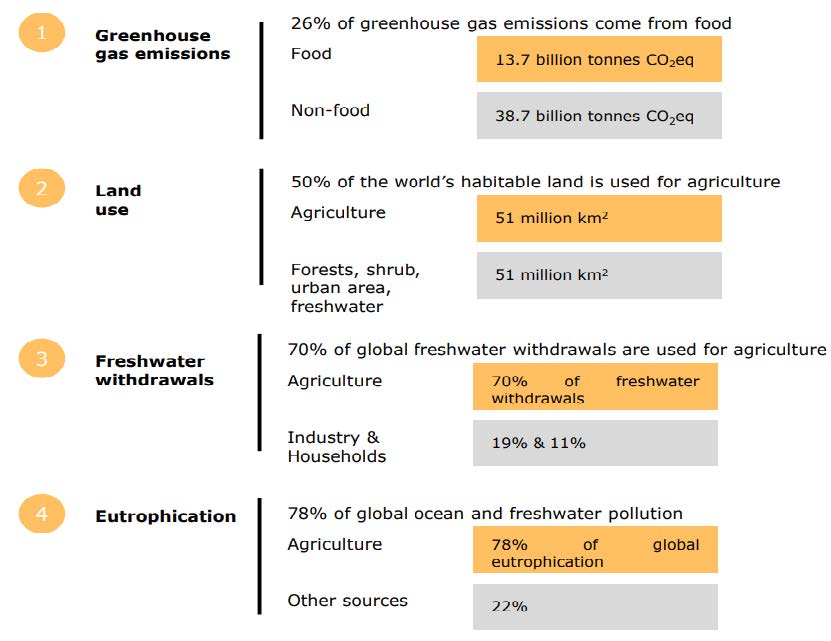
Agriculture has a massive impact on the world’s environment due to its enormous land use. Half of the world’s habitable land is used for agriculture. Agriculture requires large amounts of fresh water, which can cause significant environmental pressures in regions with water stress. As it needs water as input, agriculture practices also pollute rivers, lakes, and oceans by releasing nutrients. 78% of global ocean and freshwater is facing eutrophication, or pollution of waterways with nutrient-rich water.
The situation above further shows the importance of sustainable agriculture practices that aim to reduce emissions and promote climate resilience. agroforestry, crop diversification, and conservation agriculture, can help to increase crop yields while reducing environmental impact. Additionally, innovations such as precision agriculture, which utilizes data and technology to optimize crop management, and vertical farming, which allows for year-round, resource-efficient cultivation in urban areas, can help to increase food production and reduce the carbon footprint of food systems.
Furthermore, the adoption of circular economy principles, which aim to reduce waste and promote resource efficiency, can help to address food waste by ensuring that food products are reused or recycled wherever possible. Additionally, efforts to improve food distribution systems, such as reducing food miles by sourcing food locally, can help to reduce the carbon footprint of food systems and increase the efficiency of food distribution.
Indonesia is one of the world’s largest producers and exporters of agricultural products, supplying important commodities such as palm oil, natural rubber, cocoa, coffee, rice, and spices to the rest of the world. However, the country itself doesn’t perform that well on addressing the food related issues. Indonesian government has addressed the importance of food security in Law number 18 of 2012 concerning Food and the Nawacita. Based on the targets as set out in the 2020-2024 National Medium-Term Development Plan (RPJMN), Indonesia’s food security score is 95.2. However, in fact, Indonesia’s food security score in the Global Food Security Index ranks 63 out of 113 countries with a score of 60.2.
The State of Food Security and Nutrition in the World report released by the Food and Agriculture Organization (FAO) stated that for 2019 to 2021, Indonesia is a country with the highest number of malnourished people in the Southeast Asian region, reaching 17.7 million people, which almost as high as the number of malnourished people in all other Southeast Asian countries combined (20.9 million).
Exhibit 4: Rata-rata Jumlah Penduduk Kurang Gizi di Asia Tenggara (2019-2021)
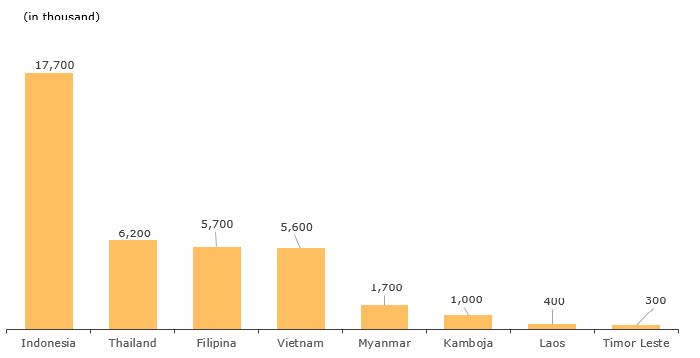
Note : Malaysia (not reported because the prevalence of malnutrition is <2.5% of the national population), Singapura & Brunei Darussalam (data not available)
Indonesian Nutrition Status Survey (Survey Status Gizi Indonesia, SSGI) of the Ministry of Health showed that Indonesia are facing four nutritional problems for toddlers in Indonesia, which are stunting, wasting, underweight and overweight. Stunting or short stature is a nutritional problem that is of concern to the government and the public because its prevalence is still quite high, reaching 21.6% in 2022. This figure exceeds the threshold set by the World Health Organization (WHO) standard of 20%. This indicates that stunting in Indonesia is still classified as chronic.
Exhibit 5: Nutritional Problems Experienced by Indonesian Toddlers According to SSGI (2019-2022)
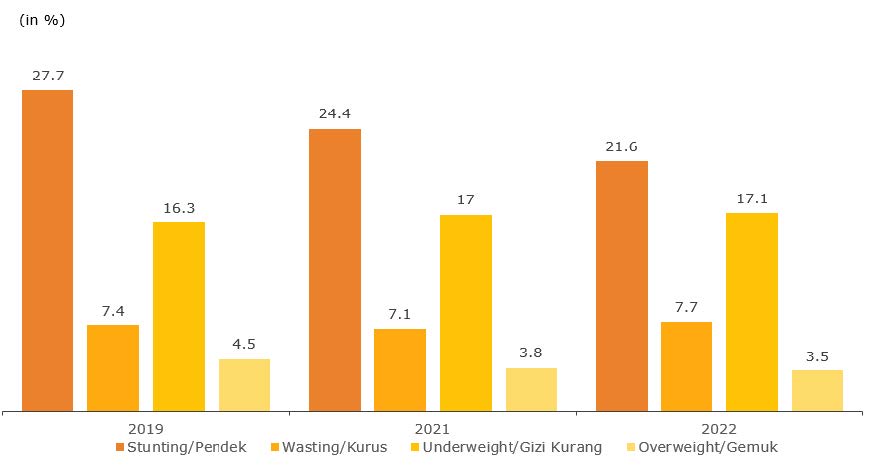
To overcome this, the government provides additional food to overcome nutritional problems in Indonesia. Endang said the government would switch from providing additional food in the form of biscuits to local food. Apart from providing additional food with local food, the most important thing is providing education to mothers about how to provide good food for children, according to Director General of Public Health Maria Endang Sumiwi. This aims to pursue the government’s target regarding reducing the stunting rate to 14% in 2024.
Endang said that a number of factors contributed to the reduction in stunting , including early initiation of breastfeeding (IMD), exclusive breastfeeding, provision of animal protein, and nutritional counseling. “The prevention of stunting is much more effective than the treatment of stunting ,” said Endang.
Food waste in Indonesia also needs to be addressed. According to the 2021 Bappenas Report, Indonesia’s food loss and food waste, the country generates 115-184 Kg of food waste per capita per year. it’s the world’s third largest, after Saudi Arabia and United States. With that number, 30 to 40% of Indonesia’s population can be fed. Though Bappenas itself has recommended several
methods and initiatives to reduce the food waste, such as further processing, used as fertilizers or animal feeds, no further initiatives are observed to solve the issue.
According to the Indonesian Ministry of Environment and Forestry’s report of Greenhouse Gas Inventory 2021, the agricultural sector contributes on average 7.5% of greenhouse gas emissions to total greenhouse gas emissions in Indonesia for 2016 to 2020, it’s the third largest sector contributor even though the agricultural sector is the most vulnerable and sensitive sector to climate change.
Table 2: National Greenhouse Gas Emission 2016-2020

The agricultural sector is one of the sectors that has become a national priority in the 2020-2024 RPJMN. In the 2020-2024 RPJMN target of reducing emissions in the agricultural sector, the Ministry of National Development Planning (BAPPENAS) has committed to reduce emissions from the land sector (agriculture included) by 58, 3% (in 2024). The government has devised mitigation activities targeted by the agricultural sector in Presidential Regulation 61/2011 through land optimization, application of plant cultivation technology, use of organic fertilizers and biopesticides, development of plantation areas (oil palm, rubber, cocoa) on non-forested land/abandoned/degraded land, and utilization of livestock manure/urine and agricultural waste for biogas. To address the issue, Low Carbon Development Indonesia along with Bappenas recommend to integrate sustainable agriculture practices in the sector, by increasing the productivity of agricultural land by 4.4% per year, while simultaneously expanding the area of sustainable agricultural land to 45% of the total agricultural land.
It turns out that improving production numbers is not the only solution to address the food related issues. There are no one-size-fits-all approach in the sector. the global issues of food security, food waste, and climate change are inextricably linked, and require a multi-faceted approach to address. Through sustainable agriculture practices, circular economy principles, and innovative solutions, we can work towards a more equitable, resilient, and sustainable global food system that ensures food security for all, reduces waste, and mitigates the effects of climate change.
Looking at the severity of the problem, we have to act quick before the food issues started to eat us all away.